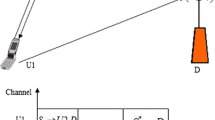Abstract
This paper presents a new Amplify-and-Forward Cooperative Automatic Repeat reQuest protocol with channel state information-assisted relay which is more suitable for the only-read access networks. The channels of any pair of terminations are quasi static flat Nakagami-\(m\) fading channels, which are mutually independent and non-identically distributed. Assuming that the coherent equal gain combining is adopted to combine the retransmitted signals from the same link at the destination and selective combining is adopted to the signals from different links. Based on the approximation of product of Nakagami-\(m\) variables, we obtain the end-to-end signal-to-noise rate of any link. The closed-form expression of the average bit error rate for several modulation schemes is obtained by analyzing cumulative distribution function (CDF) and Gaussian Q-function. Then we analyze the amount of fading of the fading channels by the \(n\) order moment which is obtained by CDF. Numerical simulation results show that the relay node can resist the fading of system effectively comparing with the system without relay node. And with the increasing of the number of transmission, the performance advantage of relay link is more and more obviously. It is better to let the maximum transmission time \(F=6\), which is very useful for improving the transmission efficiency of the truncated ARQ system. The maximum reduction of amount of fading can be reached when \(t=3\), if the total number of transmission is \(f=6\). The number of bits in the frame should not have too big.








Similar content being viewed by others
References
Nosratinia, A., Hunter, T. E., & Hedayat, A. (2004). Cooperative communication in wireless networks. IEEE on Communications Magazine, 42(10), 74–80.
Wang, S., Huang, S., & Liu, Y. (2012). Queuing analysis in amplify-and-forward cooperative diversity wireless networks with random feedback delay. AEU-International Journal of Electronics and Communications, 66(5), 410–416.
Li, J., & Zhao, Y. Q. (2009). Packet delay analysis for multichannel communication systems with MSW-ARQ. Performance Evaluation, 66(7), 380–394.
Cho, H., Lee Chanyong, I., Hwang, G. U. (2008). Performance analysis of single relay cooperative ARQ protocol under time correlated Rayleigh fading channel. In New technologies, mobility and security, NTMS’08 (pp. 1–6).
Chen, H., Cai, Y., Yang, W., & Zhang, D. (2012). Throughput and energy efficiency of a novel cooperative ARQ strategy for wireless sensor networks. Computer Communications, 35(9), 1064–1073.
Simon, M. K., & Alouini, M. S. (2005). Digital communication over fading channels (2nd ed.). New York: Wiley.
Salahat, E., & Abualhaol, I. (2013). General BER analysis over Nakagami-m fading channels. Wireless and Mobile Networking Conference (WMNC), 2013(6), 1–4.
Xu, W, X., Lin, J., & Niu, K. (2010). Performance analysis of cooperative ARQ with code combining over Nakagami-m fading channels. Wireless Personal Communications, 54(4), 559–578.
Alouini, M. S., Abdi, A., & Kaveh, M. (2001). Sum of gamma variates and performance of wireless communication systems over Nakagami fading channels. IEEE Transactions on Vehicular Technology, 50(6), 1471–1480.
Hasna, M. O., & Alouini, M. S. (2004). A performance study of dual-hop transmissions with fixed gain relays. IEEE Transactions on Wireless Communications, 3(6), 1963–1968.
Li, S., & Wu, k. (2013). MGF performance analysis of AF-CARQ with blind relay over Nakagami-\(m\) fading channels. Journal of Information & Computational Science, 13(10), 4205–4212.
Xia, M., & Aissa, S. (2012). Moments based framework for performance analysis of one-way/two-way CSI-assisted AF relaying. IEEE Journal on Selected Areas in Communications, 30(8), 1464–1476.
Gradshteyn, I. S., & Ryzhik, I. M. (1994). Table of intergrals, series, and products (5th ed.). San Diego, CA: Academic Press.
Tsiftsis, T. A., Karagiannidis, G. K., Mathiopoulos, P. T., & Kotsopoulos, S. A. (2006). Nonregenerative dual-hop cooperative links with selection diversity. EURASIP Journal on Wireless Communications and Networking, 2006(2), 1–8.
Acknowledgments
This research was supported by Grant 61167005 from the Natural Science Foundation of China, and Grant 0809RJZA019 from the Natural Science Foundation of Gansu Province.
Author information
Authors and Affiliations
Corresponding author
Appendix
Appendix
1. The pdf of \(\gamma _{eq}\).
By using Eq. (8.352.4) of [13], \(F_{\gamma _{eq}}(\gamma )\) in (17) can be written as
From Eqs. (8.356.4) and (8.486.12) of [13], the pdf of \(\gamma _{eq}\) can be given by taking derivation of (24),
where \(w=i+(f-t)m_2\).
2. The \(n\) order moment \(\mu _n\).
where \(p_1=k-j+1\);
Rights and permissions
About this article
Cite this article
Li, S., Wu, K., Zhou, Y. et al. Closed-Form Error Analysis of AF-CARQ with CSI-Assisted Relay over Nakagami-\(m\) Fading Channels. Wireless Pers Commun 78, 629–647 (2014). https://doi.org/10.1007/s11277-014-1775-2
Published:
Issue Date:
DOI: https://doi.org/10.1007/s11277-014-1775-2




